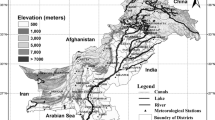Abstract
Climate change is becoming a reason for the increased frequency of drought reported in many parts of the world. An increase in temperature results in the increase in soil evaporation, thus rendering low precipitation periods drier under otherwise cooler conditions. For drought prediction, it is important to quantify the drought conditions. Several types of research have been conducted to develop univariate and multivariate drought indicators based on meteorological data and historical data. This paper gives thorough information about several indices which can be used for drought assessment, monitoring, and prediction purpose. The countries with the worst experience in drought are counted on herewith to compile the list of indices. This review paper attempts to summarize the global acceptability of various indices, reported accuracy, and identify the reasons for the wider acceptability of certain indices.
Access this chapter
Tax calculation will be finalised at checkout
Purchases are for personal use only
Similar content being viewed by others
References
Gibbs WJ, Maher JV (1967) Rainfall deciles as drought indicators. Bureau Meteorol Bull 48. Commonwealth of Australia, Melbourne, Australia
Palmer WC (1965) Meteorological drought. Research Paper No. 45. US Weather Bureau, Washington, DC
Zhang R, Chen Z-Y, Xu L-J, Ou C-Q (2019) Meteorological drought forecasting based on a statistical model with machine learning techniques in Shaanxi province, China. Sci Total Environ 665:338–346, ISSN 0048-9697. https://doi.org/10.1016/j.scitotenv.2019.01.431
McKee TB, Doesken NJ, Kleist J (1993) The relationship of drought frequency and duration to time scales. In: Proceedings of the 8th conference on applied climatology, Anaheim, CA. Boston, MA, American Meteorological Society
Narasimhan B, Srinivasan R (2005) Development and evaluation of Soil Moisture Deficit Index (SMDI) and Evapotranspiration Deficit Index (ETDI) for agricultural drought monitoring. Agric For Meteorol 133(1):69–88. https://doi.org/10.1016/j.agrformet.2005.07.012
Zuo D, Cai S, Xu Z, Peng D, Kan G, Sun W, Pang B, Yang H (2019) Assessment of meteorological and agricultural droughts using in-situ observations and remote sensing data. Agric Water Manage 222:125–138, ISSN 0378-3774. https://doi.org/10.1016/j.agwat.2019.05.046
Alijanian M, Rakhshandehroo GR, Mishra A, Dehghani M (2019) Evaluation of remotely sensed precipitation estimates using PERSIANN-CDR and MSWEP for spatio-temporal drought assessment over Iran. J Hydrol 579(124189), ISSN 0022-1694
Vidhya Lakshmi S, Ramalakshmi M, Krishnappa Rakshith R, Christobel MJ, Kumar PP, Priyadharshini B, Kumar PR (2020) An integration of geospatial technology and standard precipitation index (SPI) for drought vulnerability assessment for a part of Namakkal district, South India. Mater Today Proc 33(1):1206–1211, ISSN 2214-7853. https://doi.org/10.1016/j.matpr.2020.08.157
Li K, Tong Z, Liu X, Zhang J, Tong S (2020) Quantitative assessment and driving force analysis of vegetation drought risk to climate change: methodology and application in Northeast China. Agric Forest Meteorol 282–283 (107865), ISSN 0168-1923. https://doi.org/10.1016/j.agrformet.2019.107865
Sahana V, Sreekumar P, Mondal A, Rajsekhar D (2020) On the rarity of the 2015 drought in India: a country-wide drought atlas using the multivariate standardized drought index and copula-based severity-duration-frequency curves. J Hydrol Region Stud 31(100727), ISSN 2214-5818. https://doi.org/10.1016/j.ejrh.2020.100727
Dutta D, Kundu A, Patel NR, Saha SK, Siddiqui AR (2015) Assessment of agricultural drought in Rajasthan (India) using remote sensing derived Vegetation Condition Index (VCI) and Standardized Precipitation Index (SPI). Egyp J Rem Sens Space Sci 18(1):53–63, ISSN 1110-9823. https://doi.org/10.1016/j.ejrs.2015.03.006
Souza AGSS, Neto AR, de Souza LL (2021) Soil moisture-based index for agricultural drought assessment: SMADI application in Pernambuco State-Brazil. Rem Sens Environ 252(112124), ISSN 0034-4257. https://doi.org/10.1016/j.rse.2020.112124
Sánchez N, Gonzalez-Zamora A, Martinez-Fernández J, Piles M, Pablos M (2018) Integrated remote sensing approach to global agricultural drought monitoring. Agric For Meteorol 259:141–153. https://doi.org/10.1016/j.agrformet.2018.04.022
Sánchez N, Gonzalez-Zamora A, Piles M, Martinez-Fernández J (2016) A new soil moisture agricultural drought index (SMADI) integrating MODIS and SMOS products: a case of study over the Iberian Peninsula. Remote Sens 8:25. https://doi.org/10.3390/rs8040287
World Meteorological Organization (2012) Standardized precipitation index user guide (M. Svoboda, M. Hayes and D. Wood). (WMO-No. 1090), Geneva
Wu H, Hayes MJ, Wilhite DA, Svoboda MD (2005) The Effect of the Length of Record on the Standardized Precipitation Index Calculation. Int J Climatol 25(4):505–520. https://doi.org/10.1002/joc.1142
Haieda N, Foufou A, Chaab S, Azlaoui M, Khadri S, Benzahia K, Benzahi I (2017) Drought assessment and monitoring using meteorological indices in a semi-arid region. Energy Proc 119:518–529
Eslamian S, Ostad-Ali-Askari K, Singh V, Dalezios N, Woldeyohannes Y, Matouq M (2017) A review of drought indices. Int J Constr Res Civ Eng 3:48–66. https://doi.org/10.20431/2454-8693.0304005
Doesken NJ, Garen D (1991) Drought monitoring in the Western United States using a surface water supply index. In: Seventh conference on applied climatology, Salt Lake City, UT. American Meteorological Society, pp 266–269. https://doi.org/10.1175/1520-0442(2004)017<2335ASPDSI>2.0.CO;2
Hayes M, Svoboda M, Wall N, Widhalm M (2011) The Lincoln declaration on drought indices: universal meteorological drought index recommended. Bull Am Meteor Soc 92(4):485–488. https://doi.org/10.1175/2010BAMS3103.1
Mlenga DH, Jordaan AJ (2019) Monitoring droughts in Eswatini: a spatiotemporal variability analysis using the Standard Precipitation Index. Jamba (Potchefstroom, South Africa) 11(1):712. https://doi.org/10.4102/jamba.v11i1.712
Vicente-Serrano SM, Beguería S, López-Moreno JI (2010) A multiscalar drought index sensitive to global warming: the standardized precipitation evapotranspiration index. J Clim 23(7):1696–1718
Dai A, National Center for Atmospheric Research Staff (eds) (2019) The climate data guide: palmer drought severity index (PDSI). National Center for Atmospheric Research. https://climatedataguide.ucar.edu/climate-data/palmer-drought-severity-index-pdsi
Alley WM (1984) The Palmer Drought Severity Index: limitations and assumptions. J Appl Meteorol 23(7):1100–1109. https://doi.org/10.1175/1520-0450(1984)023%3c1100:TPDSIL%3e2.0.CO;2
Hayes MJ, Svoboda MD, Wilhite DA, Vanyarkho OV (1999) Monitoring the 1996 drought using the standardized precipitation index. Bull Am Meteor Soc 80(3):429–438
Wells N, Goddard S, Hayes MJ (2004) A self-calibrating Palmer Drought Severity Index. J Clim 17:2335–2351
Author information
Authors and Affiliations
Corresponding author
Editor information
Editors and Affiliations
Rights and permissions
Copyright information
© 2022 The Author(s), under exclusive license to Springer Nature Singapore Pte Ltd.
About this paper
Cite this paper
Singh, R., Kumari, M., Bindal, S., Gupta, I. (2022). Quantification of Drought Condition Using Drought Indices: A Review. In: Kolathayar, S., Mondal, A., Chian, S.C. (eds) Climate Change and Water Security. Lecture Notes in Civil Engineering, vol 178. Springer, Singapore. https://doi.org/10.1007/978-981-16-5501-2_19
Download citation
DOI: https://doi.org/10.1007/978-981-16-5501-2_19
Published:
Publisher Name: Springer, Singapore
Print ISBN: 978-981-16-5500-5
Online ISBN: 978-981-16-5501-2
eBook Packages: EngineeringEngineering (R0)




